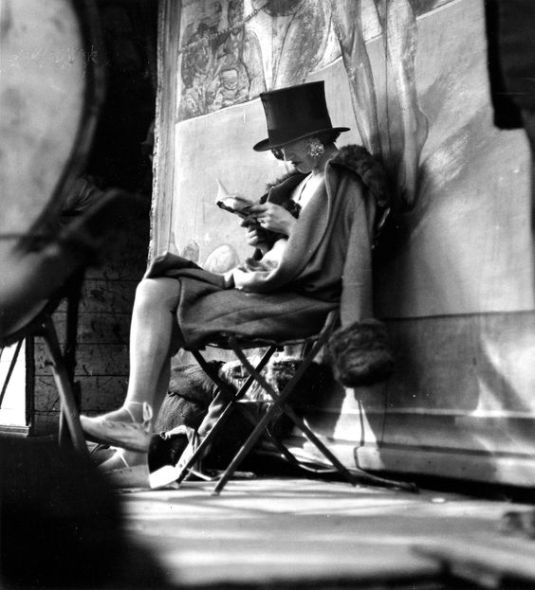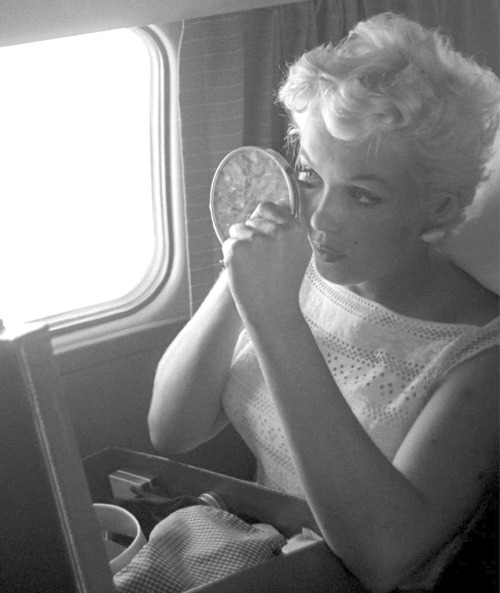
Dan Weiner, New Year’s Eve, 1951 via

Dan Weiner, New Year’s Eve, Times Square, c. 1956 via

Lisa Larsen (1925-1959) was one of LIFE’s poioneering female photojournalists. Born in Germany, she moved to the United States as a teenager. She started out as a picture file clerk at Black Star, but soon became a freelance photographer for many publications, including Vogue, The New York Times, Parade, Glamour, Charm, Holiday, and LIFE.
After 1948, the bulk of Larsen’s photojournalism was contract work for LIFE. In the beginning of her career at the influential magazine, she was assigned mainly entertainment and fashion stories, such as photographing the Vanderbilts, Kennedys, Bing Crosby, and the Duke of Windsor as well as the Greenbriar Hotel (source).
Bouvier and Kennedy were married on September 12, 1953, at St. Mary’s Church in Newport, Rhode Island, in a Mass celebrated by Boston’s Archbishop Richard Cushing. The wedding was considered the social event of the season with an estimated 700 guests at the ceremony and 1,200 at the reception that followed at Hammersmith Farm. The wedding dress, now housed in the Kennedy Library in Boston, Massachusetts, and the dresses of her attendants were created by designer Ann Lowe of New York City.




André Kertész (1894 – 1985), born Kertész Andor, was a Hungarian-born photographer known for his groundbreaking contributions to photographic composition and the photo essay.
In the early years of his career, his then-unorthodox camera angles and style prevented his work from gaining wider recognition.
Today he is considered one of the seminal figures of photojournalism.

André Kertész, “Latin Quarter,” Paris, 1926 via

André Kertész – A Window on the Quai Voltaire, Paris, 1928 via

André Kertész ”Carnival, Paris (woman reading behind stage)” 1926 Gelatin silver print 10 3/4 x 13 inches © Courtesy Estate of André Kertész/Higher Pictures 2007 via

André Kertész, My Friends at Cafe du Dome, 1928 via

André Kertész Untitled (La fontaine de la Place de la Concorde), Paris, 1925 via
Gisèle Freund (1908 – 2000) was a German-born French photographer and photojournalist, famous for her documentary photography and portraits of writers and artists. Her best-known book is Photographie et société (1974) about the uses and abuses of the photographic medium in the age of technological reproduction. In 1977, she became President of the French Association of Photographers, and in 1981, she took the official portrait of French President François Mitterrand.
She was made Officier des Arts et Lettres in 1982 and Chevalier de la Légion d’honneur, the highest decoration in France, in 1983. In 1991, she became the first photographer to be honored with a retrospective at the Musée National d’art Moderne in Paris (Centre Georges Pompidou).
Freund’s major contributions to photography include using the Leica (with its 36 frames) for documentary reportage and her early experimentation with Kodachrome and 35 mm Agfacolor, which allowed her to develop a “uniquely candid portraiture style” that distinguishes her in 20th century photography.
She is buried at the Montparnasse Cemetery in Paris, France near her home and studio at 12 rue Lalande.
Anouk Aimée by Gisèle Freund, 1962 via
Colette by Gisèle Freund, 1954 via
Frida Kahlo by Gisèle Freund via
Simone de Beauvoir by Gisèle Freund (The day of the Prix Goncourt, next to a window writing), Paris, 1954 via
Zsa Zsa Gabor, 1953 via
Evita Perón, doing her hair (Reportage for Life magazine, 1950) © Gisèle Freund via
Gisèle Freund, Self-Portrait via
Gisèle Freund (1908 – 2000) was a German-born French photographer and photojournalist, famous for her documentary photography and portraits of writers and artists.
In 1950 Freund´s photocoverage of a bejewelled Eva Peron for Life Magazine caused a diplomatic stir between the United States and Argentina — the ostentatious photographs went against the official party line of austerity. Life Magazine was blacklisted in Argentina and Freund had to escape the country.
Freund embarked on a two-week trip to Mexico, but she wouldn’t leave until two years later. There she met the legendary couple Frida Kahlo and Diego Rivera. Welcomed into their home, she immersed herself in their private lives and the cultural and artistic diversity of the country, taking hundreds of photographs (source).
Frida Kahlo by Gisèle Freund, 1950 / 1952 via
Frida Kahlo by Gisèle Freund, 1950 / 1952 via
Frida Kahlo by Gisèle Freund, 1950 / 1952 via
Frida Kahlo by Gisèle Freund, 1950 / 1952 via
Frida Kahlo by Gisèle Freund, 1950 / 1952 via
Frida Kahlo by Gisèle Freund, 1950 / 1952 via
Photographer and photojournalist Eva Besnyö was born in Budapest on April 29, 1910, who participated in the Nieuwe Fotografie (New Photography) movement.
In 1928 she began a two-year course of studies at the renowned József Pécsi Portrait, Advertising and Architecture Studio, where she also did her apprenticeship. In 1930 at the age of 20 she decided to move to Berlin, metropolis of the avant-garde, not only in order to get away from home but also in order to leave the Hungary of the Horthy regime. Later she referred to her stay in Berlin as the most important period of her life, meaning that it laid the foundations not only of her photographic practice but also of her political awareness. She became part of the social and political circle of intellectuals which included György Kepes, Joris Ivens, Lászlo Moholy-Nagy, Otto Umbehr and Robert Capa. In 1931, she opened her own studio where she was successful in receiving agency work. Her well-known photograph of the gipsy boy with a cello on his back stems from that period.
Beacause of the political climate she moved to Amsterdam in 1932 with her Dutch friend John Fernhout whom she married. With the assistance of Charley Toorop, she participated in exhibitions which led to commissions in press photography, portraits, fashion and architecture. Her solo exhibition in the Van Lier art gallery in 1933 consolidated her recognition in the Netherlands. Besnyö experienced a further breakthrough with her architectural photography only a few years later: translating the idea of functionalist “New Building” into a “New Seeing”
After the war she again received commissions for documentary work but became less active as she raised her two children fathered by the graphic designer Wim Brusse. In the 1970s, she was active in the Dutch feminist movement Dolle Mina, fighting for equal rights and photographing street protests
Eva Besnyö, Selfportrait, 1952

Eva Besnyö, 1939
Eva Besnyö, Budapest, 1929
Eva Besnyö, Shadow play web
Eva Besnyö
Eva Besnyö
Eva Besnyö
In 1950 Gisèle Freund´s photocoverage of a bejewelled Eva Peron for Life Magazine caused a diplomatic stir between the United States and Argentina and upset many of Peron’s supporters—the ostentatious photographs went against the official party line of austerity; Life Magazine was blacklisted in Argentina, Freund had to escape the country with her negatives.
Evita Perón, on national holiday, Buenos Aires, 1950
Black-and-white photograph; Fiber Base Silver Gelatine Print; white outline borde via

Evita Perón, preparing for National Holiday, Buenos Aires, 1950
Black-and-white photograph; Fiber Base Silver Gelatine Print; white outline borde via
Evita Perón, plays with her two poodles, Buenos Aires, 1950
Black-and-white photograph; Fiber Base Silver Gelatine Print; white outlin via
Evita Perón, shows her hat collection, Buenos Aires, 1950
Black-and-white photograph; Fiber Base Silver Gelatine Print; white outline border via
Eve Arnold, OBE, Hon. FRPS (née Cohen; 1912 – 2012) was an American photojournalist. She joined Magnum Photosagency in 1951, and became a full member in 1957.
Eve Arnold photographed many of the iconic figures who shaped the second half of the twentieth century, yet she was equally comfortable documenting the lives of the poor and dispossessed, “migrant workers, civil-rights protestors of apartheid in South Africa, disabled Vietnam war veterans and Mongolian herdsmen.” For Arnold, there was no dichotomy: “”I don’t see anybody as either ordinary or extraordinary,” she said in a 1990 BBC interview, “I see them simply as people in front of my lens.” She also photographed Queen Elizabeth II, Malcolm X, and Joan Crawford, and traveled around the world, photographing in China, Russia, South Africa and Afghanistan
Arnold’s images of Marilyn Monroe on the set of The Misfits (1961) were perhaps her most memorable, but she had taken many photos of Monroe from 1951 onwards. She said about photographing Marilyn:
I found myself in the privileged position of photographing somebody who I had first thought had a gift for the camera, but who turned out had a genius for it. She had a naive quality, but she also had a great sense of showmanship and self-promotion. She was very clever. She was able to assess each photographer. Even if it was only an amateur with a box camera, she worked with the same intensity and diligence that she would have if she were working with a top professional. She would photograph ten pounds lighter which is against every rule in the book. The smile was brilliant. Her skin was translucent, white, luminous. She was always sort of golden-looking, and because she had a down of just very fine golden hairs on her face it trapped the light and caused an aureole to form, giving her a faint glow. It was extraordinary. I’ve never seen it before. It was a nimbus, so that she looked almost angelic.
Arnold left the United States and moved permanently to England in the early 1960s with her son, Frank Arnold. While working for the London Sunday Times, she began to make serious use of colour photography. Her previously unseen photos of Monroe were shown at an Halcyon Gallery exhibition in London during May 2005.

Photo by Eve Arnold, 1955 via

Photo by Eve Arnold, 1955 via

Photo by Eve Arnold, 1955 via

Photo by Eve Arnold, 1955 via